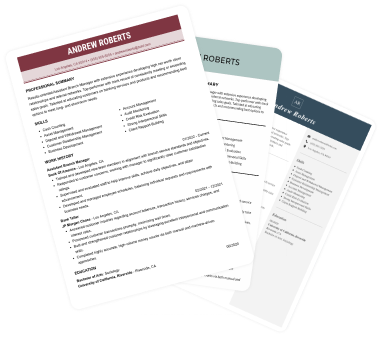
How To Write a Skills Based CV: Template and Examples
See when to use a skills based CV and how to write it for the UK job market. Learn from the free skills based CV examples and download a functional CV template.
December 29, 2025
Last updated on 19 December, 2025
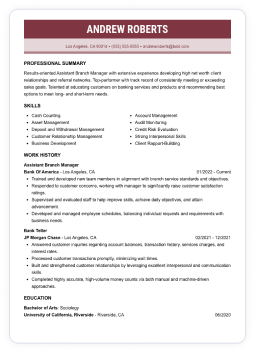
Whether you're applying for an exhibition, residency, grant, or job in the arts, your artist CV needs to showcase your talent and professionalism at a glance. From listing exhibitions and commissions to crafting a compelling personal statement, each section should showcase your unique voice and creative journey.
Let me walk you through every part of the process, helping you tailor your art CV to different opportunities and present your work clearly and convincingly.
In this guide, you’ll see:
Create an effective CV in minutes. Choose a professional CV template and fill in every section of your CV in a flash using ready-made content and expert tips.
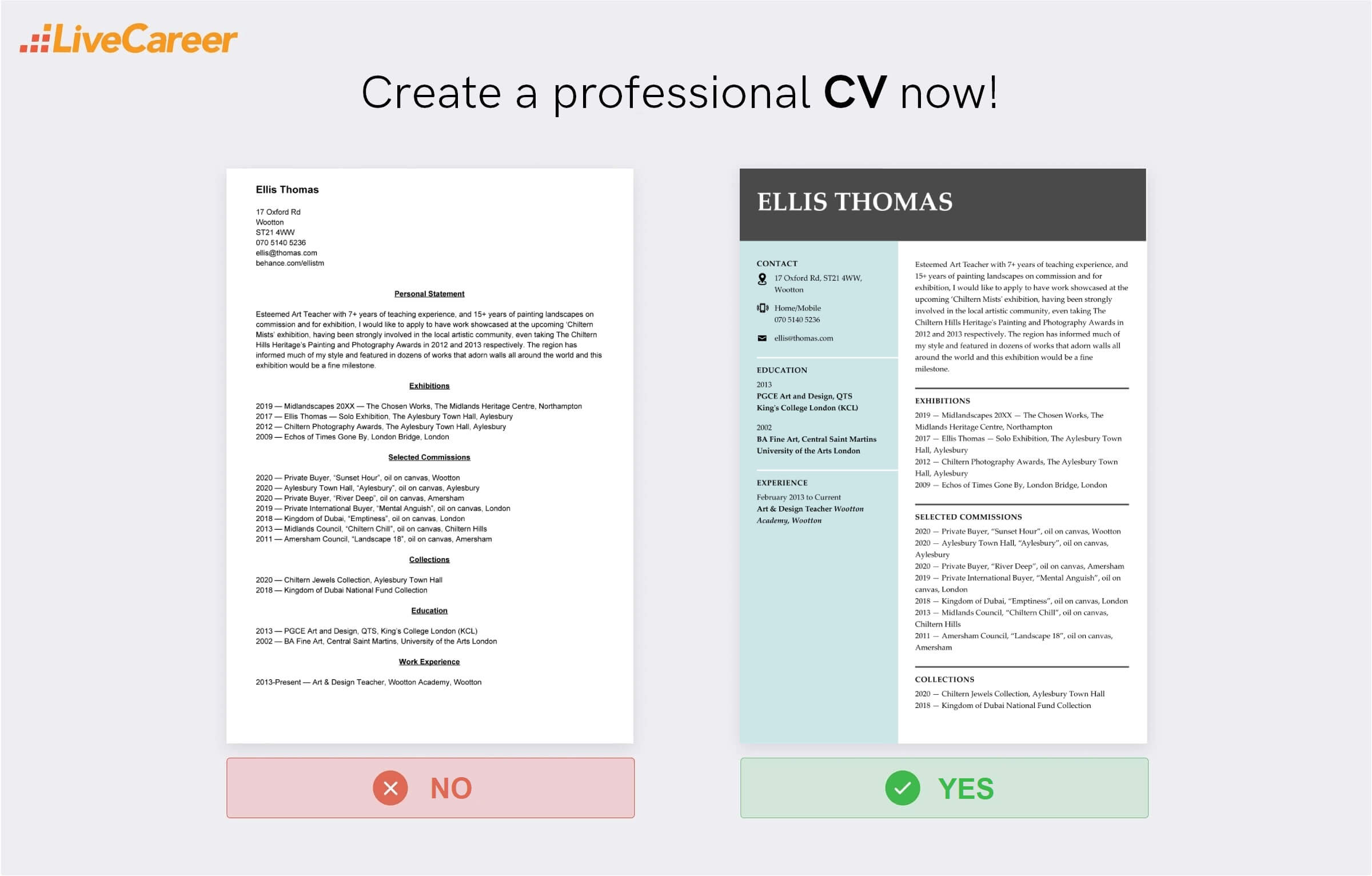
Ellis Thomas
Artist
17 Oxford Rd
Wootton
ST21 4WW
070 5140 5236
ellis@thomas.com
behance.com/ellistm
Personal Statement
Esteemed artist with 15+ years of painting landscapes on commission and for exhibition, I would like to apply to have work showcased at the upcoming ‘Chiltern Mists’ exhibition, having been intensely involved in the local artistic community, even earning The Chiltern Hills Heritage’s Painting and Photography Awards in 2012 and 2013, respectively. The region has greatly influenced my style and is featured in dozens of works that adorn walls worldwide. An exhibition at the Doherty Gallery would be a significant milestone in my career.
Exhibitions
2019 — Midlandscapes 20XX: The Chosen Works, The Midlands Heritage Centre, Northampton
2017 — Ellis Thomas: Solo Exhibition, The Aylesbury Town Hall, Aylesbury
2012 — Chiltern Photography Awards, The Aylesbury Town Hall, Aylesbury
2009 — Echos of Times Gone By, London Bridge, London
Selected Commissions
2021 — Private Buyer, “Sunset Hour”, oil on canvas, Wootton
2020 — Aylesbury Town Hall, “Aylesbury”, oil on canvas, Aylesbury
2020 — Private Buyer, “River Deep”, oil on canvas, Amersham
2019 — Private International Buyer, “Mental Anguish”, oil on canvas, London
2018 — Kingdom of Dubai, “Emptiness”, oil on canvas, London
2013 — Midlands Council, “Chiltern Chill”, oil on canvas, Chiltern Hills
2011 — Amersham Council, “Landscape 18”, oil on canvas, Amersham
Collections
2020 — Chiltern Jewels Collection, Aylesbury Town Hall
2018 — Kingdom of Dubai National Fund Collection
Education
PGCE in Art and Design with QTS
King’s College London (KCL)
Graduated: 2013
BA (Hons) Fine Art
Central Saint Martins, University of the Arts London
Graduated with honours: 2002
Work Experience
Art & Design Teacher
Wootton Academy, Wootton
January 2013–Present
Skills
Professional Membership
Volunteering
Languages
That’s a quick sketch of an art CV and how your CV should look. Here's how to write your own CV for an artist:
Your personal statement is the first thing a gallery owner, curator, or hiring manager will read, so it must make an impact. Whether you're applying for an exhibition, a residency, or a position in an arts institution, this CV introduction sets the tone for the rest of your document. Consider it your artistic slogan: concise, focused, and persuasive.
To craft a strong personal statement, answer these key questions:
While doing so, make sure to follow these tips:
Write this part of your CV last, once all the other sections are in place. That will make it all much easier. Below, see a sample artist CV summary:
Esteemed artist with 15+ years of painting landscapes on commission and for exhibition, I would like to apply to have work showcased at the upcoming ‘Chiltern Mists’ exhibition, having been intensely involved in the local artistic community, even earning The Chiltern Hills Heritage’s Painting and Photography Awards in 2012 and 2013, respectively. The region has greatly influenced my style and is featured in dozens of works that adorn walls worldwide. An exhibition at the Doherty Gallery would be a significant milestone in my career.
A strong CV summary will convince the recruiter you’re the perfect candidate. Save time and choose a ready-made personal statement written by career experts and adjust it to your needs in the LiveCareer CV builder.
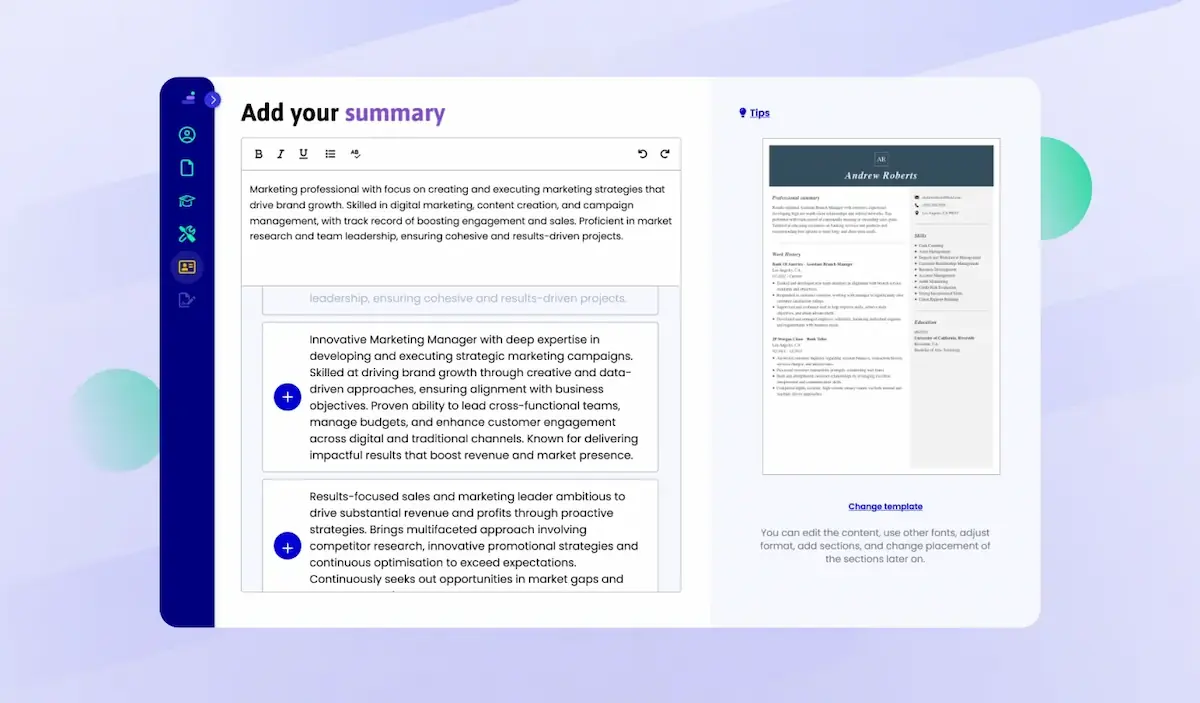
In our artist CV example, Ellis is attempting to get his work exhibited in a gallery exhibition.
Therefore, it’s natural to prioritise the ‘Exhibitions’ section, listing some similar in status and subject. Then it follows with ‘Commissions’, to show that there is interest.
Depending on the kind of job or artist opportunity you’re pursuing, you should adjust the focus of your CV accordingly:
You may also adapt additional CV sections, such as volunteer work, to demonstrate your commitment and broader contribution to the arts. Plus, mention memberships in art organisations, especially if it’s one of the UK’s nine national art societies.
Expert advice: If your artistic path is still emerging, focus on education, selected projects, and group exhibitions, and consider including artist statements or creative intentions to give context to your developing voice. If you have undertaken residencies or international exchanges, prominently display the information to reflect your development and reputation within the art world.
Here’s how to list your artistic experiences on a CV:
Exhibitions
2019 — Midlandscapes 20XX, The Midlands Heritage Centre, Northampton
2017 — Ellis Thomas: Solo Exhibition, The Aylesbury Town Hall, Aylesbury
2012 — Chiltern Photography Awards, The Aylesbury Town Hall, Aylesbury
2009 — Echos of Times Gone By, London Bridge, London
Selected Commissions
2021 — Private Buyer, “Sunset Hour”, oil on canvas, Wootton
2020 — Aylesbury Town Hall, “Aylesbury”, oil on canvas, Aylesbury
2020 — Private Buyer, “River Deep”, oil on canvas, Amersham
2019 — Private International Buyer, “Mental Anguish”, oil on canvas, London
2018 — Kingdom of Dubai, “Emptiness”, oil on canvas, London
2013 — Midlands Council, “Chiltern Chill”, oil on canvas, Chiltern Hills
2011 — Amersham Council, “Landscape 18”, oil on canvas, Amersham
Collections
2020 — Chiltern Jewels Collection, Aylesbury Town Hall
2018 — Kingdom of Dubai National Fund Collection
You must always present your educational background on a CV. For formal employment and teaching positions, consider repositioning the education section to the end of the personal statement.
To show your educational credentials on your artist CV:
PGCE in Art and Design with QTS
King’s College London (KCL)
Graduated: 2013
BA (Hons) Fine Art
Central Saint Martins, University of the Arts London
Graduated with honours: 2002
Your work experience should highlight your practical skills, creative contributions, and professional development. For teaching roles, place this section after your statement and focus on the impact you've made in each position. If your experience isn’t directly related, keep it concise and emphasise transferable skills.
Here’s how to create a good work experience section on an artist CV:
Work Experience
Art & Design Teacher
Wootton Academy, Wootton
January 2013–Present
Even if you are early in your artistic career or have limited formal work experience, your skills are a crucial part of your CV. Employers, galleries, and commissioners want to see not only your creativity but also your practical and professional abilities. Highlighting the right mix of soft skills and hard skills can set you apart and show how you can contribute effectively to a project or role.
Here’s how to build a strong skills section for your artist CV:
Some of the most valuable and relevant skills for an artist’s CV include:
tutaj
By clearly presenting your skills with real examples, you help employers and galleries understand not only what you do, but how well you do it, and why you’re the right artist for the opportunity.
Whether you’re applying for a residency or an exhibition, you can include other valuable sections on your artist CV to make it stand out even more.
There are many sections to choose from, such as:
The order of those is up to you and should be adjusted accordingly. Even if you don't need this CV for a few years, it's time to start thinking about adding to it. The Royal Society of British Artists opens an annual call for entries to apply to join its ranks.
Professional Membership
Volunteering
Languages
I’m not about to tell an artist how to design their calling card. That’s up to you. All I can offer is the traditional advice on a general CV format, which may serve as a good starting point.
Here’s what we do:
Expert advice: Keep a record of the applications you send out and follow up after a couple of weeks to inquire about their status. That could be just the spark they need.
You need to make your application stand out. Do it with two additional pieces of application art, and your recruiter can marvel. Let’s start with a cover letter.
The optimal cover letter structure has following parts:
Ensure you craft a targeted CV for each application you submit. That may seem obvious for exhibitions, but it should be obvious when applying for any kind of formal job.
A well-curated portfolio is essential for any artist applying for exhibitions, residencies, commissions, or jobs. It provides tangible evidence of your skills, style, and artistic journey. When submitting a portfolio, whether as part of your art CV or alongside your application, clarity and relevance are crucial. Your portfolio should showcase your best work and demonstrate the range and depth of your practice, tailored specifically to the opportunity you are pursuing.
How to include your portfolio:
A portfolio for a creative role stands out when it's visually appealing and well-organised, letting the work speak for itself without overwhelming the viewer. While creativity matters, clarity and specificity are crucial—highlight relevant projects that show a strong understanding of the brand, audience, and campaign goals. A well-structured CV that ties your creative work to measurable results is often more impactful than a purely artistic presentation.
You don’t have to be a CV writing expert. In the LiveCareer CV builder you’ll find ready-made content for every industry and position, which you can then add with a single click.
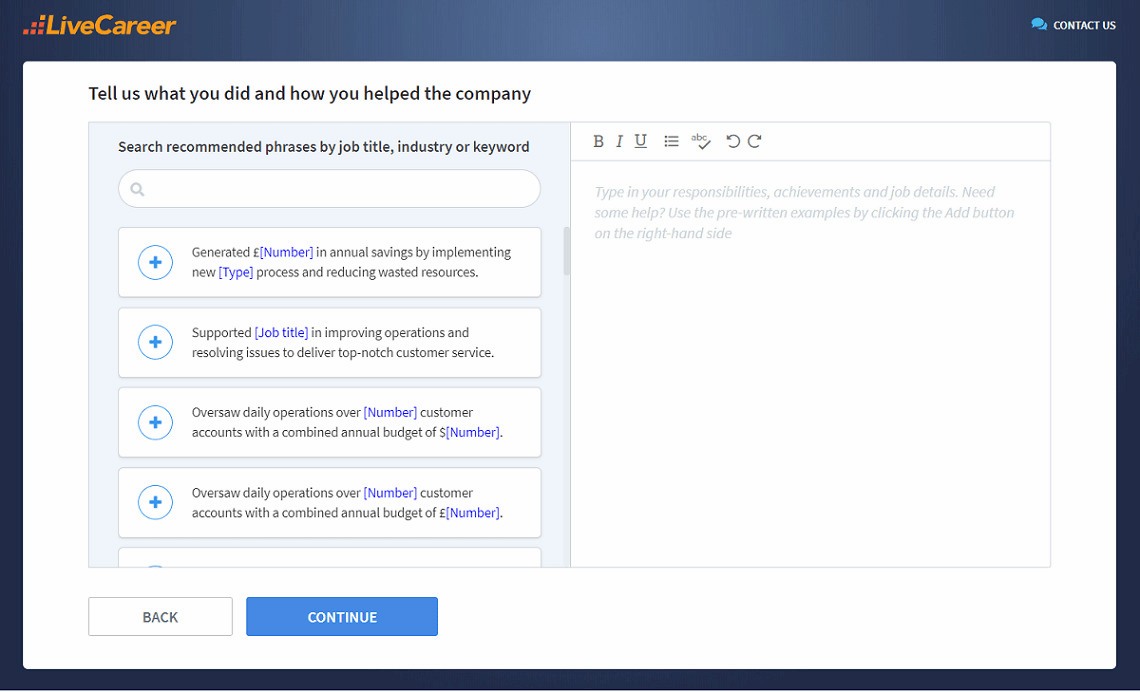
Need a different CV? Check our other CV samples:
Haven't found your job? Check our full list of professional CV examples.
Our editorial team has reviewed this article for compliance with Livecareer’s editorial guidelines. It’s to ensure that our expert advice and recommendations are consistent across all our career guides and align with current CV and cover letter writing standards and trends. We’re trusted by over 10 million job seekers, supporting them on their way to finding their dream job. Each article is preceded by research and scrutiny to ensure our content responds to current market trends and demand.
Category: CV Examples
Crafting a job-winning CV is all about showcasing your unique skills and experiences. Start with a strong personal statement that highlights your career goals and achievements.
Try Our CV Builder Now